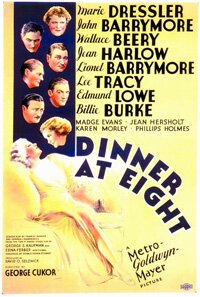 Directed by George Cukor
Directed by George Cukor
Producer David O. Selznick, having had great success with his star-studded blockbuster Grand Hotel, decided to do it again. If it worked once, why not twice? And so we have 1933’s Dinner at Eight, packed with stars (many the same) and with a similar story idea.
As often happens, though, the second time around isn’t quite as good as the first – at least not for me. This part-comedy, largely soap opera, extravaganza seems to drag and drag.
Again, we have a large group of people.
They are well-to-do, socialites – business successes who have worked themselves up from the bottom, artists who have made their way to the top and heirs and heiresses.
But all is not as light and easy as the surface may indicate. While some are still doing well, many of these people have come upon hard times and are doing their best to maintain their laissez-faire outward appearances while scrambling to keep from going under.
This is very much like Grand Hotel, where most of the characters are facing some kind of crisis – certainly the main ones do.
And that’s fine – it can make for an engaging film. But in this case I think there are script problems. Based on a play, Dinner at Eight remains too true to its source, at least in some respects.
In the first half of the film in particular … Many of the scenes that introduce characters and go through the expository business of letting us know who they are, and what their situation is, are far too long.
On stage, the scenes probably work and practically speaking, you can’t go back and forth from scene to scene.
But with film, you can intercut. You can break a long scene up or at least pare it down so it doesn’t drag so much. But Dinner at Eight doesn’t do this.
And yes, in 1933 the cinematic approach doesn’t include today’s rapid cutting (for which we’re grateful) but it doesn’t alter the fact that the scenes are way too long.
The early scenes with Lionel Barrymore are almost painfully slow.
It does pick up however, especially when we finally get to meet Jean Harlow, who is a joy to watch. She brings a wonderful note of comedy to the film and infuses it with some badly needed energy.
Another jewel within the film is Marie Dressler as an aging star of the theatre. She brings wit and intelligence to the film (and has the movie’s best line).
But the movie taken as a whole doesn’t really work for me. Some of the acting is excessively over-the-top, especially in the melodramatic scenes, and this really makes the film feel old (a sense you don’t get in the earlier Grand Hotel).
While there are good moments, maybe even great ones, Dinner at Eight just left me looking at my watch to see when it would end.
The DVD
For a film from 1933 the image and sound are pretty good – but keep in mind, the film is from 1933. There is some graininess but for the most part they’ve managed to put a pretty good looking film on the disc.
There are a few special features including a roughly 45 minute profile called Harlow: The Blonde Bombshell, hosted by Sharon Stone. This is a made-for-TV documentary from 1993 that gives a good overview of Jean Harlow though it’s generally pretty stilted. The transitional parts with Stone onscreen (as opposed to voice over narration) are pretty stagy.
Also see:
- Grand Hotel (1932)
On Amazon:
- Dinner at Eight — Amazon.com (U.S.)
- Dinner at Eight — Amazon.ca (Canada)



[“Producer David O. Selznick, having had great success with his star-studded blockbuster Grand Hotel, decided to do it again. If it worked once, why not twice? And so we have 1933’s Dinner at Eight, packed with stars (many the same) and with a similar story idea.”]
Irving Thalberg was the producer behind “Grand Hotel”, not David Selznick. The latter was still production chief at RKO, when “Grand Hotel” was made by Thalberg at MGM. Selznick joined the production ranks at MGM a few months into 1933.